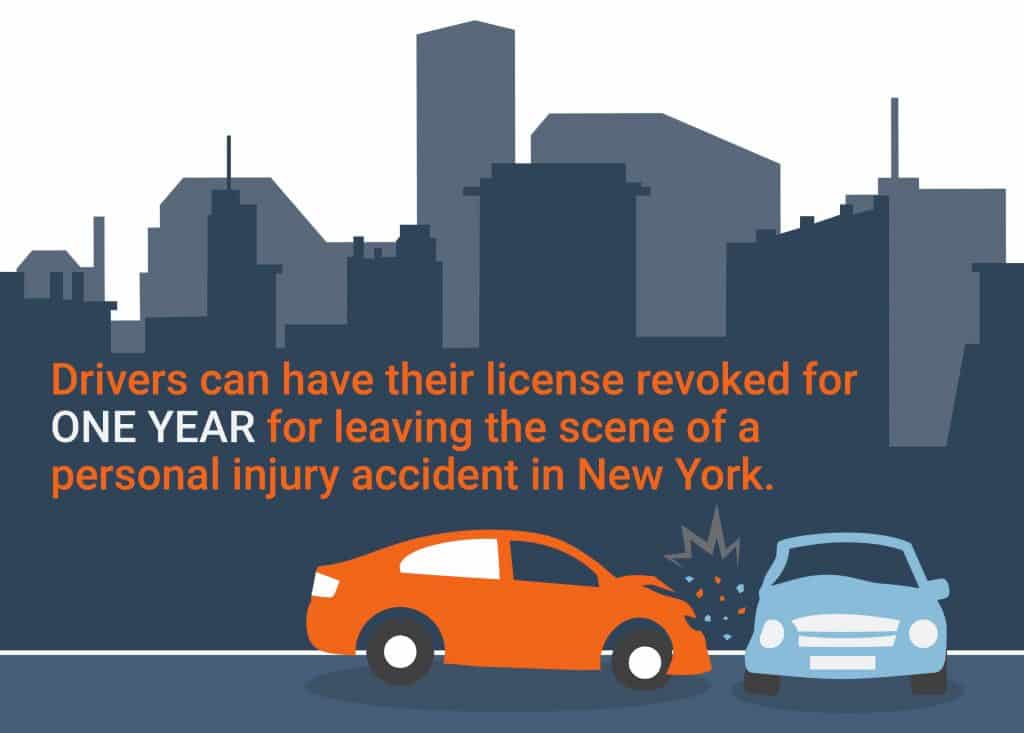Drivers involved in a car accident in New York are required by law to stop and share insurance information with the other driver(s) before leaving the scene. If one or more persons are injured in an accident, the drivers are also required to call the police and wait for an officer to file a report. Failure to do one or both can mean being charged with leaving the scene of an accident
Important: For minor property-damage-only accidents, a person does not have to call police but still must stop and exchange insurance and contact information.
What Are the Penalties for Leaving the Scene of an Accident in New York?
Leaving the scene of an accident in NY involving injuries is a crime with a penalty of up to one year in jail. Leaving the scene of a crash involving serious injuries or death is a felony in NY with a potential sentence of up to 7 years.
Fines: The fine for leaving the scene of an accident in NY costs between $0 and $250 if only property damage is involved (no injuries). If there are injuries, the fine is between $250 and $5,000 depending on the severity of the injuries.
Surcharge: New York State imposes a mandatory surcharge of $88 to $93 for leaving the scene of an accident in which no or minor injuries occur.
Points: Drivers will receive 3 points if convicted of leaving the scene of an accident involving no or minor injuries.
License Revocation: Regular drivers can have their license revoked for one year for leaving the scene of a personal injury accident in New York. For CDL drivers, even if there are no injuries, leaving the scene of an accident can mean a one-year revocation.
Jail: Leaving the scene of an accident with no injuries can mean spending up to 15 days in jail. Refusing to provide insurance information following an accident with injuries can mean facing up to three months in jail or up to one year for leaving the scene before police arrive.
Criminal Record: Leaving the scene of an accident resulting in injuries is a crime and a conviction means having a permanent criminal record. A criminal record can have negative consequences on many different aspects of one’s life.

Different Types of Hit-and-Run Charges in New York
There are two statutes that cover unlawfully leaving the scene of an accident. VTL 600-1a is for accidents in which there is only property damage and no injuries. The statute establishes that a driver is who is or may have been at fault in a property-damage-only accident must share license and insurance information with other driver(s) involved. It is not required for drivers to call the police or wait for police to arrive when no one is injured in an accident and the estimated cost of the damage is less than $1,000.
Under VTL 600-2a, when an accident involves injuries drivers involved must, if physically able, call police and file a report. They also must share personal and insurance information with other parties involved in the accident. This is true regardless of who is at fault for the accident. Failing to do either is a violation of the statute. There are separate penalties for failing to share insurance information and for leaving the scene before police arrive. Doing both means facing two charges under the statute.
Notice: In a single-car accident (e.g., where a vehicle strikes a tree or telephone pole), a person must still call the police if a passenger is injured.

Need help with your hit-and-run charges?
Call Now - We've Fought Over 50,000 Traffic Ticket Cases
Quick, free, and no obligation.
Common Defenses to Leaving the Scene of an Accident in NY
Although it might seem quite tough to defend a hit-and-run charge, it is possible. Contrary to popular belief, there actually are several valid defenses against a charge for violating VTL 600-1a.
First, “mistake of fact” is usually a great defense that will give someone a fighting chance at getting the charge lowered. If a person honestly did not know that he/she struck another vehicle (e.g. were backing out of a parking space, etc.) or truly believed there was no damage and simply assumed he/she was being “waved on” by the vehicle struck, then these facts would allow an attorney to present a mistake-of-fact defense. Remember, this does not work every time and one may not get the ticket dismissed, but it is absolutely worth using as long as it is true for in that case.
Second, it is important to realize that any statement that made to an officer that has been coerced in what the law calls a “custodial interrogation”—which in some cases could happen right on the side of the road—can be suppressed as a violation of one’s Miranda rights. If this applies to a specific case and the attorney believes it crucial, this defense can be raised to help get those confessions or statements excluded and prevent them from being used against the driver in court.
Case Law Analysis
Although the New York case law regarding VTL 600-1a is complicated, a common thread appears to run through the overwhelming majority of them: verbal evidence from the driver can make or break the prosecution’s case (see People v. Briggs, 38 NY 2d 319; People v. Lewis, 162 AD 2d 760).
Did you
know?


Kent Ng
The case law indicates that admitting to the officer that someone hit a car and ran off spells disaster. It might seem obvious to keep quiet and not make any admissions. However, when drivers get nervous and the officer asks what happened, many people will blurt things out like “I didn’t mean to hit him!” more often than you might think.
These types of admissions cannot be excluded from court because they are considered excited utterances and exceptions to the hearsay rule (see People v. Edwards, 47 NY 2d 493). Moreover, if they are made when a person is not officially being interrogated or in custody, Miranda does not apply. Therefore, these admissions are legally used against drivers to help convict them. What is the takeaway? Be careful! Do not say anything that could even imply that you were responsible.
Lastly, the most amazing precedent that is still on the books in NY comes from People v. Hager, 124 Misc. 2d 123. In this case, the court was forced to decide whether a driver must have intent in order to be convicted of leaving the scene of an accident.
Amazingly, the court ruled that because VTL 600-1a and VTL 600-2a are crimes, an intent component is required to convict. Consequently, because facts in the record indicated that the driver in Hager was mentally disturbed at the time of fleeing the scene and that he could not recall what truly transpired, his conviction was upended and he got a new trial.
It is unclear how other courts would rule on this, but two things are for sure: 1) a reputable NY court determined that a driver must intend to flee the scene in order to be convicted and 2) being mentally disturbed—even for a short period of time—might be enough to get a hit-and-run ticket dismissed on appeal.

How a NY Hit-and-Run (Leaving the Scene of an Accident) Charge Affects Out-of-State Drivers
Drivers who live in another state should not assume that they can leave the scene of an accident without facing the consequences. Even minor accidents with no injuries and minimal damage can catch up with a driver if they fail to comply with the law and exchange insurance information. If necessary, it is possible for police to get information from out-of-state licensing authorities to issue charges against drivers who flee accidents. Regardless of the state in which one is licensed to drive, a traffic ticket or other charge from New York authorities must be answered. Out-of-state drivers who refuse to respond to a charge of leaving the scene of an accident can have their right to drive in New York suspended.
Key Takeaways
- Any admission that one was aware of having been in an accident and leaving the scene can be used against a person in hit-and-run cases.
- A person must have intended to flee the scene in order to be convicted of a hit-and-run.
- A person who lacks mental cognizance or who might otherwise not recall/notice the impact may be able to beat a hit-and-run charge.
- Even if a person has unintentionally confessed to leaving the scene or was caught on video, an attorney may be able to negotiate a reduction in penalties.
Common Questions
- Do I have to call police after an accident if no one is injured?
No. However, information must be exchanged and a person must still file an accident report with the DMV using form MV-104 if the property damage is more than $1,000.
- How long do I have to report an accident?
Drivers have 10 days to report an accident with no injuries. Drivers must call police and file a report immediately in the case of accidents involving injuries.
- Is it a felony to leave the scene of an accident?
In some cases, yes. If the accident is property damage only, then the offense is a traffic violation. A first offense for leaving the scene of an accident involving minor injuries is a misdemeanor. It is also a misdemeanor to fail to provide information for accidents involving any level of injuries. A second offense for leaving the scene of an accident involving minor injuries is a felony. It is also a felony to leave the scene of an accident involving serious injury or death. See the following chart.
- What if I hit something other than a car?
Drivers are still required to report single-car accidents if they involve damage to one’s own or another person’s property. However, unless a person is injured, it is not necessary to call the police.
See the following chart for the severity of the offense.
| Violation | Level of Damage | Severity of Offense |
| Not sharing information | Property Only | Traffic Violation |
| Not sharing information | Injuries (any level) | Misdemeanor |
| Leaving scene | Property Only | Traffic Violation |
| Leaving scene | Minor injuries | Misdemeanor |
| Leaving scene | Serious injuries | Class E Felony |
| Leaving scene | Death | Class D Felony |
Data on NY Hit-and-Run (Leaving the Scene of an Accident) Tickets in New York
In 2018, there were 11,280 instances of drivers being charged with leaving the scene of an accident in New York. This is slightly less than the number of tickets issued for leaving the scene in 2016 (11,389). Over the past 10 years, the number of tickets issued for such an offense has remained fairly consistent, with approximately 11,000 such tickets being written each year.
Suffolk County issued the most such tickets in 2018, with 1,093. It is followed by Erie (949), Westchester (753) and Nassau (717).
Statewide, leaving the scene of an accident represents about 0.3% of all traffic tickets issued in the state each year. However, it is slightly more common in some counties. For example, in 2018 just shy of 1% of all tickets written in Orleans, Schenectady and Niagara counties were for violations of VTL 600.


